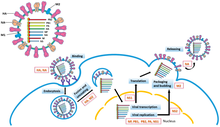Virus classification is the process of naming viruses and placing them into a taxonomic system similar to the classification systems used for cellular organisms.

Bunyavirales is an order of segmented negative-strand RNA viruses with mainly tripartite genomes. Member viruses infect arthropods, plants, protozoans, and vertebrates. It is the only order in the class Ellioviricetes. The name Bunyavirales derives from Bunyamwera, where the original type species Bunyamwera orthobunyavirus was first discovered. Ellioviricetes is named in honor of late virologist Richard M. Elliott for his early work on bunyaviruses.

Aspiviridae, formerly Ophioviridae, is a family of segmented negative-strand RNA viruses which infect plants. Member viruses are characterized by an elongated and highly filamentous and flexible nucleocapsid with helical symmetry. It is a monotypic taxon containing only one genus, Ophiovirus. Aspiviridae is also the only family in the order Serpentovirales, which in turn is the only order in the class Milneviricetes.
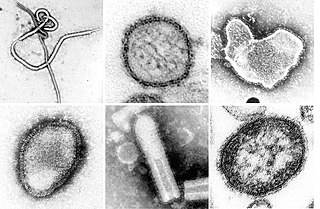
Negative-strand RNA viruses are a group of related viruses that have negative-sense, single-stranded genomes made of ribonucleic acid. They have genomes that act as complementary strands from which messenger RNA (mRNA) is synthesized by the viral enzyme RNA-dependent RNA polymerase (RdRp). During replication of the viral genome, RdRp synthesizes a positive-sense antigenome that it uses as a template to create genomic negative-sense RNA. Negative-strand RNA viruses also share a number of other characteristics: most contain a viral envelope that surrounds the capsid, which encases the viral genome, −ssRNA virus genomes are usually linear, and it is common for their genome to be segmented.
Yuyuevirus is a genus of negative-strand RNA viruses which infect invertebrates. Member viruses have bisegmented genomes. It is the only genus in the family Yueviridae, which in turn is the only family in the order Goujianvirales and class Yunchangviricetes. Two species are recognized: Beihai yuyuevirus and Shahe yuyuevirus.
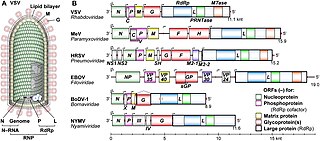
Haploviricotina is a subphylum of viruses in the phylum Negarnaviricota. It is one of only two virus subphyla, the other being Polyploviricotina, which is also in Negarnaviricota. The name comes from ἁπλό haplo, the Ancient Greek for 'simple', along with the suffix for a virus subphylum; 'viricotina'.

Polyploviricotina is a subphylum of viruses in the phylum Negarnaviricota. It is one of only two virus subphyla, the other being Haploviricotina, which is also in Negarnaviricota. The name comes from πολύπλοκο polyplo, the Ancient Greek for 'complex', along with the suffix for a virus subphylum; 'viricotina'.
Mivirus is a genus of negative-strand RNA viruses which infect arthropods. Member viruses have nonsegmented and bisegmented genomes. There are nine species in the genus.
Yingvirus is a genus of negative-strand RNA viruses which infect invertebrates. Member viruses have bisegmented genomes. It is the only genus in the family Qinviridae, which is the only family in Muvirales, which is the only order in Chunqiuviricetes. There are eight species in the genus.

Monjiviricetes is a class of negative-strand RNA viruses which infect fungi, plants, invertebrates, and vertebrates. The name is a portmanteau of the two orders within the class, Mononegavirales and Jingchuvirales and the suffix for a virus class -viricetes.
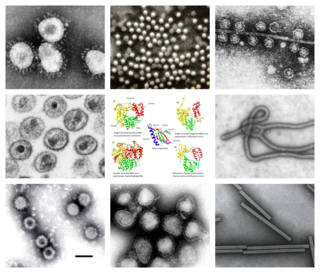
Riboviria is a realm of viruses that includes all viruses that use a homologous RNA-dependent polymerase for replication. It includes RNA viruses that encode an RNA-dependent RNA polymerase, as well as reverse-transcribing viruses that encode an RNA-dependent DNA polymerase. RNA-dependent RNA polymerase (RdRp), also called RNA replicase, produces RNA from RNA. RNA-dependent DNA polymerase (RdDp), also called reverse transcriptase (RT), produces DNA from RNA. These enzymes are essential for replicating the viral genome and transcribing viral genes into messenger RNA (mRNA) for translation of viral proteins.
In virology, realm is the highest taxonomic rank established for viruses by the International Committee on Taxonomy of Viruses (ICTV), which oversees virus taxonomy. Six virus realms are recognized and united by specific highly conserved traits:
Alsuviricetes is a class of positive-strand RNA viruses which infect eukaryotes. The name of the group is a syllabic abbreviation of "alpha supergroup" with the suffix -viricetes indicating a virus class.
Nodamuvirales is an order of positive-strand RNA viruses which infect eukaryotes. The name of the group is a contraction of "Nodamura virus" and -virales which is the suffix for a virus order.
Tolivirales is an order of RNA viruses which infect insects and plants. Member viruses have a positive-sense single-stranded RNA genome. The virions are non-enveloped, spherical, and have an icosahedral capsid. The name of the group is a syllabic abbreviation of "tombusvirus-like" with the suffix -virales indicating a virus order.
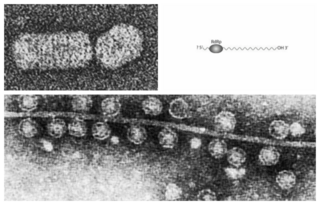
Lenarviricota is a phylum of RNA viruses that includes all positive-strand RNA viruses that infect prokaryotes. Some members also infect eukaryotes. Most of these viruses do not have capsids, except for the genus Ourmiavirus. The name of the group is a syllabic abbreviation of the names of founding member families "Leviviridae and Narnaviridae" with the suffix -viricota, denoting a virus phylum.
Durnavirales is an order of double-stranded RNA viruses which infect eukaryotes. The name of the group derives from Italian duplo which means double, rna for the type of virus, and -virales which is the suffix for a virus order.

Sobelivirales is an order of RNA viruses which infect eukaryotes. Member viruses have a positive-sense single-stranded RNA genome. The name of the group is a portmanteau of member orders "sobemovirus-like" and -virales which is the suffix for a virus order.

Adnaviria is a realm of viruses that includes archaeal viruses that have a filamentous virion and a linear, double-stranded DNA genome. The genome exists in A-form (A-DNA) and encodes a dimeric major capsid protein (MCP) that contains the SIRV2 fold, a type of alpha-helix bundle containing four helices. The virion consists of the genome encased in capsid proteins to form a helical nucleoprotein complex. For some viruses, this helix is surrounded by a lipid membrane called an envelope. Some contain an additional protein layer between the nucleoprotein helix and the envelope. Complete virions are long and thin and may be flexible or a stiff like a rod.
Naldaviricetes is a class of viruses, which infect arthropods. Members of Naldaviricetes are characterized by large enveloped rod-shaped virions, circular double-stranded DNA genomes, and replication in the nucleus of the host cell. All of them share a set of unique genes not found in other viruses, which include the presence of multiple interspersed direct repeats, various subunits of DNA polymerase and RNA polymerase, four late expression factor genes, and infectivity factor genes suggesting a common host entry mechanism.
